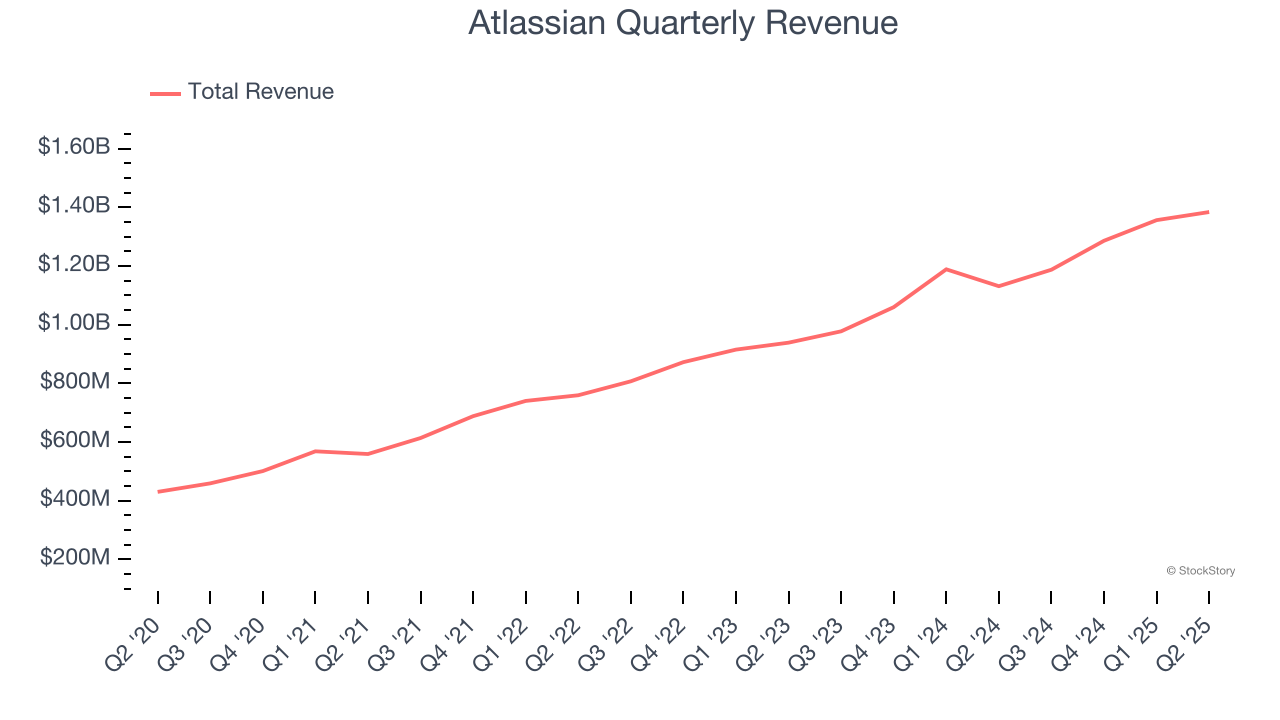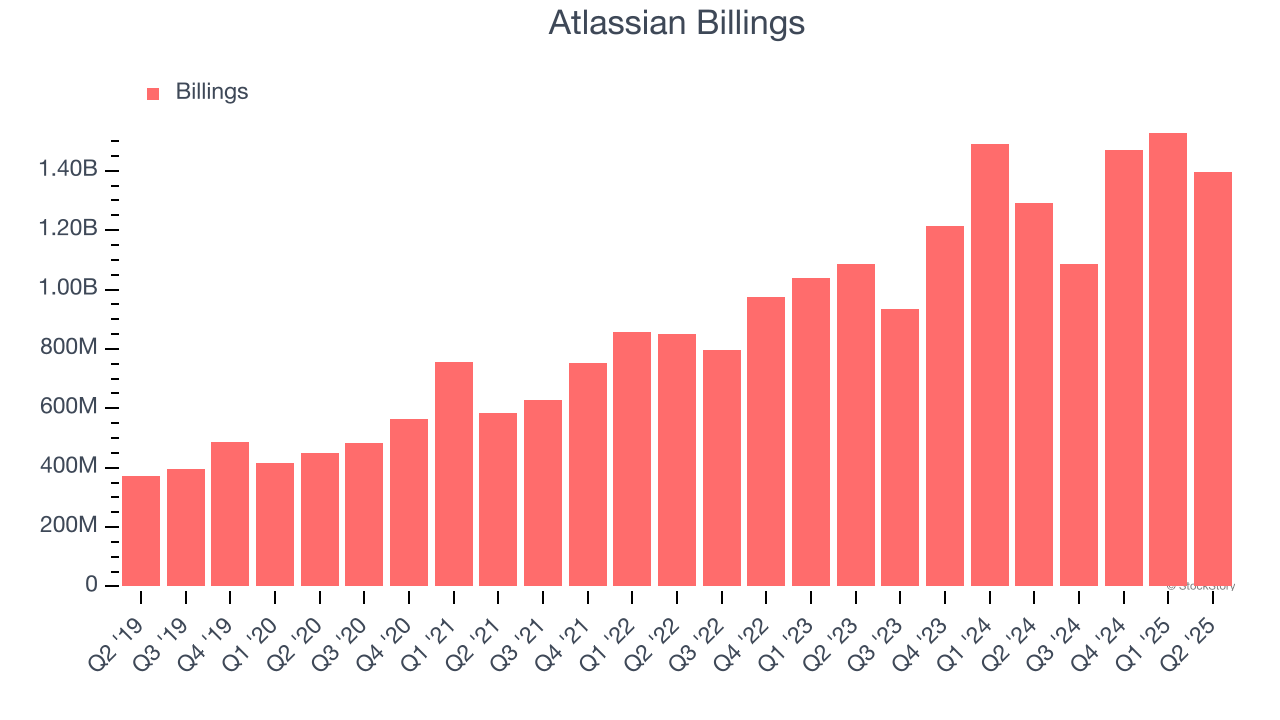
IT project management software company, Atlassian (NASDAQ:TEAM) reported Q2 CY2025 results beating Wall Street’s revenue expectations, with sales up 22.3% year on year to $1.38 billion. On the other hand, next quarter’s revenue guidance of $1.40 billion was less impressive, coming in 0.8% below analysts’ estimates. Its non-GAAP profit of $0.98 per share was 14.6% above analysts’ consensus estimates.
Is now the time to buy Atlassian? Find out by accessing our full research report, it’s free.
Atlassian (TEAM) Q2 CY2025 Highlights:
- Revenue: $1.38 billion vs analyst estimates of $1.36 billion (22.3% year-on-year growth, 2.1% beat)
- Adjusted EPS: $0.98 vs analyst estimates of $0.85 (14.6% beat)
- Adjusted Operating Income: $335.9 million vs analyst estimates of $302.8 million (24.3% margin, 10.9% beat)
- Revenue Guidance for Q3 CY2025 is $1.40 billion at the midpoint, below analyst estimates of $1.41 billion
- Operating Margin: -2.1%, up from -5.9% in the same quarter last year
- Free Cash Flow Margin: 26%, down from 47% in the previous quarter
- Billings: $1.40 billion at quarter end, up 8.1% year on year
- Market Capitalization: $48.69 billion
“We closed out FY25 delivering over $5.2 billion of revenue, generating over $1.4 billion in free cash flow, and reaching 2.3 million AI monthly active users,” said Mike Cannon-Brookes, Atlassian’s CEO and co-Founder.
Company Overview
Founded by Australian co-CEOs Mike Cannon-Brookes and Scott Farquhar in 2002, Atlassian (NASDAQ:TEAM) provides software as a service that makes it easier for large teams of software developers to manage projects, especially in software development.
Revenue Growth
A company’s long-term sales performance is one signal of its overall quality. Any business can put up a good quarter or two, but many enduring ones grow for years. Over the last three years, Atlassian grew its sales at a decent 23% compounded annual growth rate. Its growth was slightly above the average software company and shows its offerings resonate with customers.

This quarter, Atlassian reported robust year-on-year revenue growth of 22.3%, and its $1.38 billion of revenue topped Wall Street estimates by 2.1%. Company management is currently guiding for a 17.8% year-on-year increase in sales next quarter.
Looking further ahead, sell-side analysts expect revenue to grow 17.8% over the next 12 months, a deceleration versus the last three years. Still, this projection is commendable and suggests the market is baking in success for its products and services.
Here at StockStory, we certainly understand the potential of thematic investing. Diverse winners from Microsoft (MSFT) to Alphabet (GOOG), Coca-Cola (KO) to Monster Beverage (MNST) could all have been identified as promising growth stories with a megatrend driving the growth. So, in that spirit, we’ve identified a relatively under-the-radar profitable growth stock benefiting from the rise of AI, available to you FREE via this link.
Billings
Billings is a non-GAAP metric that is often called “cash revenue” because it shows how much money the company has collected from customers in a certain period. This is different from revenue, which must be recognized in pieces over the length of a contract.
Atlassian’s billings punched in at $1.40 billion in Q2, and over the last four quarters, its growth slightly outpaced the sector as it averaged 12% year-on-year increases. This alternate topline metric grew slower than total sales, meaning the company recognizes revenue faster than it collects cash - a headwind for its liquidity that could also signal a slowdown in future revenue growth. 
Customer Acquisition Efficiency
The customer acquisition cost (CAC) payback period represents the months required to recover the cost of acquiring a new customer. Essentially, it’s the break-even point for sales and marketing investments. A shorter CAC payback period is ideal, as it implies better returns on investment and business scalability.
Atlassian is extremely efficient at acquiring new customers, and its CAC payback period checked in at 19.4 months this quarter. The company’s rapid recovery of its customer acquisition costs indicates it has a highly differentiated product offering and a strong brand reputation. These dynamics give Atlassian more resources to pursue new product initiatives while maintaining the flexibility to increase its sales and marketing investments.
Key Takeaways from Atlassian’s Q2 Results
It was encouraging to see Atlassian beat analysts’ revenue expectations this quarter. On the other hand, its billings missed and its revenue guidance for next quarter fell slightly short of Wall Street’s estimates. Overall, this was a weaker quarter. The stock remained flat at $169.11 immediately after reporting.
Atlassian didn’t show it’s best hand this quarter, but does that create an opportunity to buy the stock right now? The latest quarter does matter, but not nearly as much as longer-term fundamentals and valuation, when deciding if the stock is a buy. We cover that in our actionable full research report which you can read here, it’s free.
